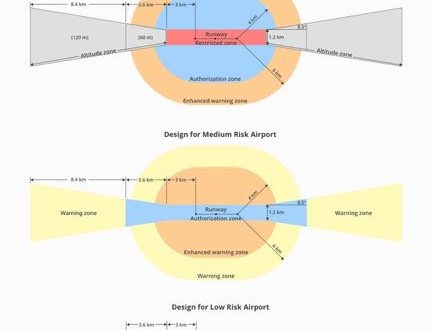DJI has announced improvements to its geofencing technology. The move will refine airspace limitations for drone flights near airports to provide better protection to airplanes in sensitive areas.
The GEO update will be backed by geospatial data from PrecisionHawk, replacing Airmap, the Santa Monica-based company DJI had been working with since 2015.
GEO 2.0 will be phased in from November. The revised zones will first take effect around airports in the United States. Upgrades in other regions will follow.
“DJI is proud to once again lead the industry in developing proactive solutions for safety and security concerns,” said Brendan Schulman, DJI Vice President of Policy & Legal Affairs. “This is an enormous step forward for safely integrating drones into the airspace based on a more finely-tuned evaluation of risks associated with aircraft approaching and departing different types of airports.”
A smarter GEO system
Instead of simple circles, the new GEO system will create detailed three-dimensional “bow tie” safety zones surrounding runway flight paths, as well as more complex polygon shapes around other sensitive facilities. This flexibility is required to better reflect the actual safety risks posed by operating drones in those areas.
It will also open up flights to the side of runways, where risk is substantially lower. DJI has shifted its geofencing feature to accommodate broader understandings of airspace and airport risk. You can see how the Chinese manufacturer applied expertise from general aviation pilots through the Aircraft Owners and Pilots Association (AOPA) and with airports through the American Association of Airport Executives (AAAE), on the chart below.
GEO 2.0 applies detailed, risk-based airspace boundaries to the airspace around airports that can be considered to involve relative high, medium, and low risk:
DJI’s new geofencing also incorporates the elements of the recently-enacted U.S. Federal Aviation Administration (FAA) Reauthorization Act. For example, the final approach corridor for active runways at major airports are set to be “runway exclusion zones” for unauthorized drones.
DJI customers should update their DJI GO 4 flight control app and aircraft firmware to ensure these improvements are implemented.
“AOPA applauds DJI’s leadership in geofencing technology, and we appreciate their collaboration with our teams, to create safe and effective systems that allow all to safely enjoy the freedom to fly,” said AOPA President and CEO Mark Baker. “These latest improvements promote safe UAS integration in our aviation community by tailoring the geofence areas around each airport in a manner that has clear advantages for manned and unmanned operators.”
“AAAE appreciates DJI’s efforts to implement these important geofencing improvements,” said Justin Barkowski, AAAE Staff Vice President, Regulatory Affairs. “This is a common-sense approach to enhancing safety in the airport operating environment while providing users with additional areas to safely operate their drones.”
Evolving the GEO system
DJI’s GEO system has received criticism in the past. First, for having the temerity to police flights of its drones in sensitive locations (something most in the industry actively supports). And second, because commercial pilots have – anecdotally, at least – not been provided with permission to fly in a timely enough manner.
GEO prevents DJI drones from taking off in certain locations without special authorization. Although drone pilots with verified DJI accounts can unlock certain no-fly zones providing they have legitimate reasons and the necessary approvals. DJI have said that the approval process has been streamlined to ensure that professional drone pilots with authorization receive unlocking codes within 30 minutes.
The GEO system previously geofenced a 5-mile circle around airports, with enhanced restrictions in a smaller circle encompassing the airport area. The new rectangle system should open more areas on the sides of runways to beneficial drone uses and more low-altitude areas more than 3 kilometers (1.9 miles) from the end of a runway, while increasing protection in the locations where manned aircraft actually fly.
Tensions between AirMap and DJI reach tipping point
Arguably the major talking point from the new GEO update is that DJI has chosen a new data provider, PrecisionHawk. That means that AirMap will no longer be providing geospatial data for DJI’s maps.
“DJI is pleased to partner with companies that support our vision of safe skies that are open to innovation,” Schulman said. “DJI pioneered geofencing for drones, as well as automatic altitude limitations, collision avoidance sensors and a mandatory knowledge quiz about safe flight rules. PrecisionHawk shares DJI’s commitment to ensuring that safety technology enhances the ability of recreational and professional drone pilots to fly.”
But there’s a little more to this than PrecisionHawk’s data capabilities.
AirMap and company co-founder Greg McNeal have long advocated handing over the right to regulate airspace to state and local governments, first through the Drone Federalism Act, which would allow cities, towns and counties to carve up airspace, charge pilots for flying, and generally make it more difficult for recreational and commercial pilots to take to the skies within the law.
For AirMap the opportunity is clear: the more complexity in the airspace, the more money the company stands to make through simplifying that complexity.
Unsurprisingly, the position that skies above the U.S. should become trickier to navigate for drone professionals and enthusiasts is not one that DJI would share.
Malek Murison is a freelance writer and editor with a passion for tech trends and innovation. He handles product reviews, major releases and keeps an eye on the enthusiast market for DroneLife.
Email Malek
Twitter:@malekmurison
Subscribe to DroneLife here.
https://dronelife.com/2018/10/24/dji-refines-geofencing-and-ditches-airmap-for-precisionhawk/
 Unmanned Aerial Vehicle The latest drone news
Unmanned Aerial Vehicle The latest drone news





